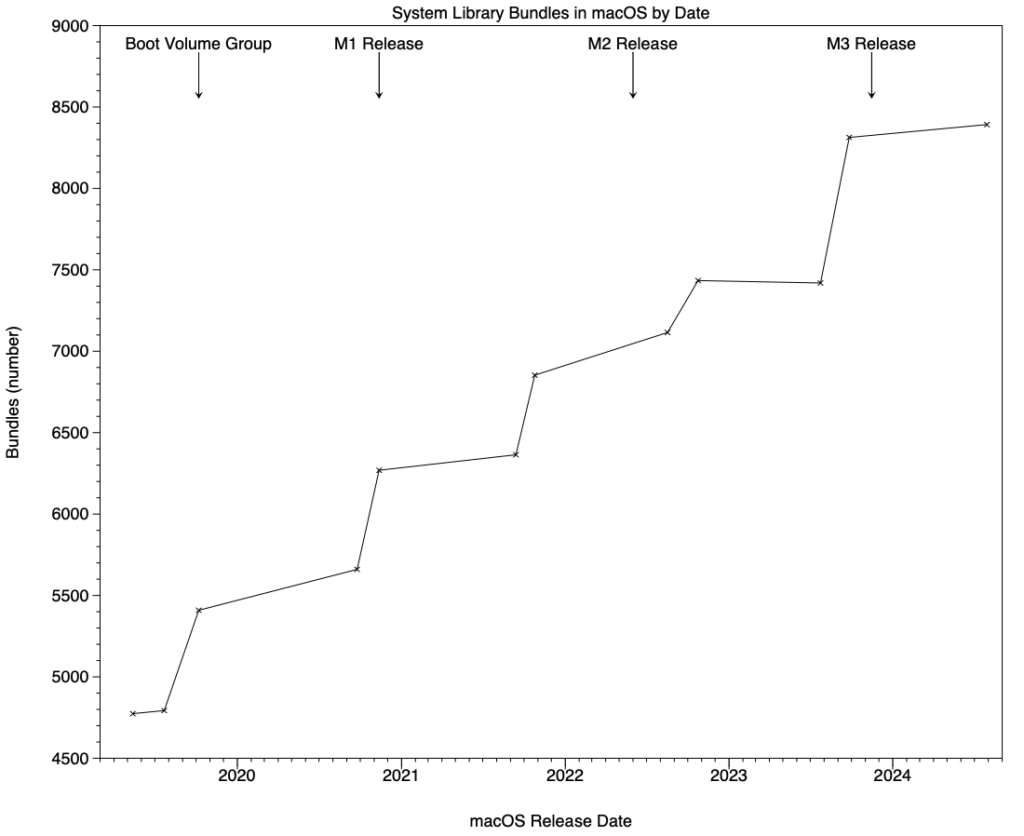What changed in macOS Sonoma? End of term report

Earlier this year, I wrote about the changes that had taken place in the System between Mojave and Sonoma 14.2.1. Now that 14.6 is out of the door and Sonoma is about to enter its two years of security-only maintenance, this article looks at how it progressed through its year as the current version of macOS. Those still running Monterey or earlier and wondering whether to upgrade now might like to take notes.
Over the last year, Sonoma has continued in the tradition of expanding the contents of the macOS System. Compared to late versions of Mojave in 2019, the number of bundles in the System library folder at /System/Library has increased by 175%, from 4,774 to 8,392, as shown in the chart below.
Steep rises in the number of bundles took place with the appearance of the boot volume group in Catalina, then again shortly before the release of the first M1 Macs, and their M3 successors in later 2023, but less so prior to the M2.
This is shown more clearly in the numbers of kernel extension bundles. New hardware often requires new kernel extensions for support, as well as their delivering architecture-specific features such as lightweight virtualisation on Apple silicon Macs. The total number of kernel extension bundles has risen from 680 in 10.15.6 to 772 in 14.6. Ironically, this is the same period over which Apple has been deprecating third-party kernel extensions, which are now decidedly uncommon on Apple silicon Macs.
Comparisons between folders within the /System/Library folder, between the last full releases of Catalina (10.15.6) and Sonoma (14.6), provide deeper insights as to just where that growth has taken place.
Greatest growth has been in Private Frameworks, which have almost doubled in number, from 2,055 to 3,803, now accounting for 45% of bundles in /System/Library. Those form the private API in macOS; public Frameworks have only risen from 600 to 772, now accounting for less than a tenth of all bundles. Thus the major increase in macOS has come in code that isn’t accessible to third-parties, only to Apple.
If you’re running a Sequoia beta, you might like to compare the figures for Extensions and the total number of bundles in /System/Library to see whether there’s any sharp increase to support the introduction of the M4 chip, or for Apple Intelligence in 15.1. I’m putting my money on the next Macs being from the M3 family, and expecting sudden rapid growth in bundles coming slightly later to support the introduction of AI.
There’s finer detail that you might have missed. During Sonoma’s year, Contact Key Verification was introduced for Messages, to ensure that your messages only reach those intended, although it requires all devices using the same Apple ID to be running recent versions of macOS/iOS/iPadOS. In lightweight virtualization, a bug was fixed that had prevented the VMs of older versions of macOS from updating with their security releases.
Among the new kernel extensions are some apparently supporting a new kernel architecture feature of Exclaves. Those include ExclaveSEPManagerProxy and ExclavesAudioKext, which might be concerned with those enhancements to virtualisation supporting the use of Apple ID in Sequoia.
Sonoma 14.4 in particular brought many new Private Frameworks, some with intriguing names include CascadeEngine, CascadeSets, Dendrite, DendriteIngest, several Poirot frameworks, SemanticPerception, and SonicKit. In other updates there were Cosmo and Tabi.
Since its release, updates to Sonoma appear to have brought mostly minor enhancements and new features, together with clearing a substantial backlog of bugs. This seems to have been a good opportunity to evolve and consolidate rather than rushing ahead with changes.




